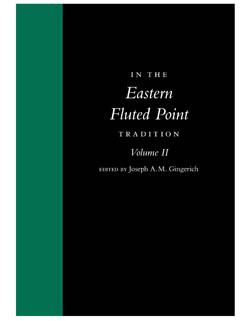
Dr. Joseph Gingerich
Dr. Joseph Gingerich, Assistant Professor of Anthropology, edited volume II of In the Eastern Fluted Point Tradition, being released in December 2017 by the University of Utah Press.
In the Eastern Fluted Point Tradition is a two-part volume that details the archaeology of some of the first people in eastern North America. Archaeological evidence shows that early American Indian groups were in the region more than 13,000 years ago. These people referred to as Paleoindians mark the first widespread populations in North America. Uniquely manufactured stone spear points, which exhibit a channel or “flute” driven from base, are a diagnostic artifact of the period and represents the first widespread cultural phenomenon in North America.
 Volume II of In the Eastern Fluted Point Tradition follows the first volume published in 2013. Together, 37 chapters provide individual site reports and regional analyses, which advance our knowledge of people living in the region between 11,000 and 13,000 years ago. The artifact and site-specific studies published in these two volumes serve as examples of the detailed analyses required on Paleoindian assemblages to better understand changes in population, technology, and settlement over time. These volumes advance Paleoindian studies in eastern North America, offering new data, interpretations, and hypotheses to create a baseline for future research.
Volume II of In the Eastern Fluted Point Tradition follows the first volume published in 2013. Together, 37 chapters provide individual site reports and regional analyses, which advance our knowledge of people living in the region between 11,000 and 13,000 years ago. The artifact and site-specific studies published in these two volumes serve as examples of the detailed analyses required on Paleoindian assemblages to better understand changes in population, technology, and settlement over time. These volumes advance Paleoindian studies in eastern North America, offering new data, interpretations, and hypotheses to create a baseline for future research.
Praise and Reviews for In the Eastern Fluted Point Tradition, Vol. I & II:
“Provides a valuable compendium of Paleoindian sites and data, including several previously unreported or under-reported sites. This volume will serve as an important reference and data source, not just for Paleoindian researchers, but also for archaeologists with broader interests in North American prehistory.”
—Canadian Journal of Archaeology
“The volume has a vast amount of outstanding technical content. It is a major and important work of scholarship that will be widely read by professional and avocational archaeologists alike. Like volume I, this will be a basic reference for the next several decades.”
—David G. Anderson, University of Tennessee, Anthropology
“This book significantly advances our understanding of human populations in the eastern North America during the late Pleistocene. Collectively, the site studies and synthetic chapters provide new insights on eastern Paleoindian adaptations to the changing environments these people encountered at the end of Ice Age. Such research offers a timely human perspective from the past as we contemplate abrupt climate change today.”
—Jonathan Lothrop, Curator of Archaeology, New York State Museum



















Comments